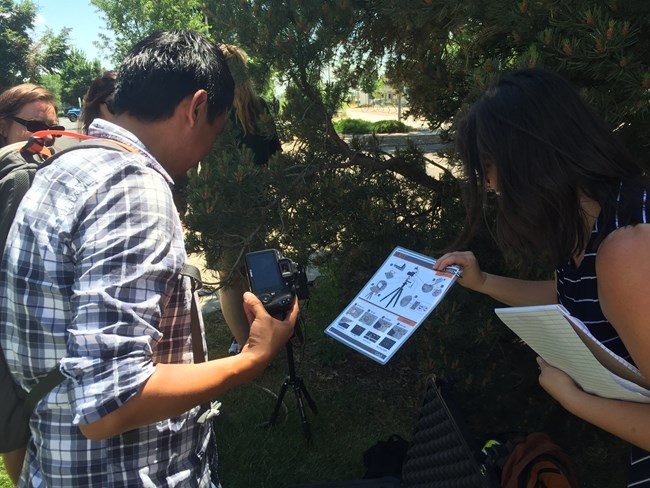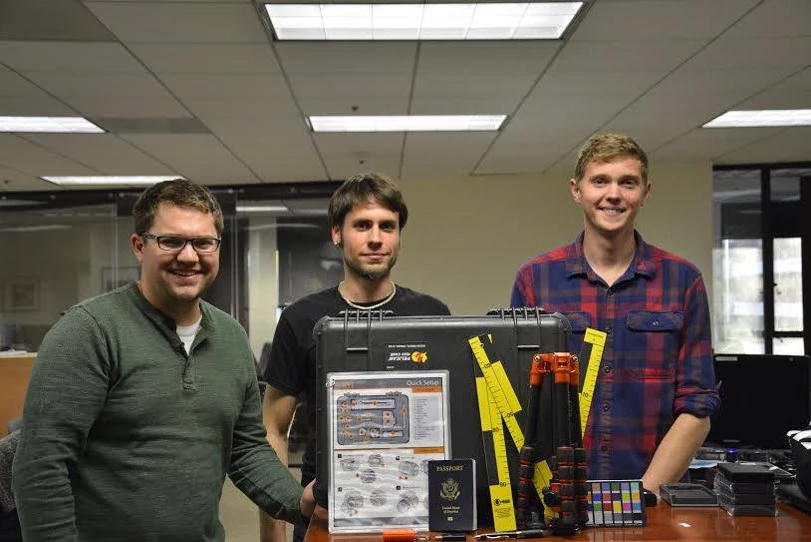Last updated: March 23, 2022
Article
PRESERVING HERITAGE WITH LOW COST DOCUMENTATION
Grant Number:
P15AP00370
Principle Investigator:
Scott Lee, Director of Operations
Project Team:
- Scott Lee, Director of Operations
- Ross Davison, Field Manager
- Brinker Ferguson, Production Manager
- Valerio Paolucci, Production Specialist
- Center for Environmental Management of Military Lands
- UNESCO Field Office
- CoPR - University of Colorado Denver
Institution/Organization:
CyArk
2201 Broadway, Suite 602
Oakland, CA 94612
EXECUTIVE SUMMARY
With support through a grant from the National Center for Preservation Technology and Training (NCPTT), CyArk developed a low-cost heritage documentation kit for use by heritage professionals around the world. The kit includes a digital camera, laser distance meter, tablet computer, GPS receiver and a compact tripod. Accompanying the kit are video tutorials on how to digitally document a site as well as upload the data to the internet. This inexpensive solution, under $1500, can be deployed quickly and relies on advances in photogrammetry software combined with limited laser scan measurements to quickly and accurately document heritage sites, thus requiring only moderate technical ability. Three kits were deployed by CyArk and were given to the Center of Preservation Research (CoPR) at the University of Colorado Denver, the Center for Environmental Management of Military Lands (CEMML) and UNESCO. The hardware inventory and accompanying materials are made freely available to any interested parties via the CyArk website and third party services such as YouTube.
Following work on the heritage documentation kit and motivated by software developments over the past several years that allow laser scan data to be used in conjunction with photogrammetric documentation, CyArk has revamped its own heritage documentation methods in order to utilize both technologies to the fullest degree. The combination of both datasets yields more realistic digital models with even higher resolution, providing the most accurate documentation to date of a site and allowing future site managers to better gauge deterioration over time.
INTRODUCTION
The need for a low cost documentation kit grew out of CyArk’s experience working with cultural heritage groups around the world, especially following social and environmental disasters. In early 2015, in response to the catastrophic loss of cultural heritage in the Middle East, CyArk formed Project Anqa. The premise behind Project Anqa is that the many heritage sites and museums destroyed in Syria and Iraq are a great loss to humanity, and yet they represent only a small portion of all the sites in high risk areas across the Middle East. Sites which have not been destroyed are even more susceptible to deliberate destruction and looting. While physically safeguarding these sites is problematic if not impossible, it is possible to proactively document these sites on an emergency basis. Project Anqa is a collaborative project between the International Council on Monuments and Sites (ICOMOS), the non-profit organization CyArk and Yale University’s Institute for the Preservation of Cultural Heritage (IPCH).

In launching Project Anqa it was necessary to design alternative systems for capture, especially when it was not possible to use 3D scanners to record the monuments. CyArk applied for and received a generous grant from the NCPTT to develop a low cost kit which could be used to equip teams for the emergency recording of heritage sites. This grant was further matched through funding from Iron Mountain to support the development and testing of the kit. Under the grant CyArk developed a low cost kit that combined the principles of photogrammetry with a low cost laser distance meter to provide scale to the images. A key component of the kit was to use off-the-shelf components so they could be easily obtained by anyone, including outside the initial testing period and to develop methods and take-away resources that could be easily adopted and referenced in the field.
METHODS AND MATERIALS
The project was divided into four phases, each focusing on a different element of designing, testing and distributing the kit.
For phase 1: Kit Development, we completed the research and development phase of the low cost documentation kit yielding accurate 3D models and orthorectifed imagery. At CyArk, we tested the kit on small and large structures and objects around the Bay Area including a trip to the Fine Arts Museum of San Francisco accompanied by Autodesk in November of 2015. The conservation team at the Fine Arts Museum of San Francisco arranged for us to test the kit on a variety of objects that were diverse in size and materials. This was done both in the museum gallery as well as in the conservation lab. Through local testing with the CyArk team we were able to streamline the process of setup, capture, and processing, and make important alterations to the hardware and software decisions for the kit.

In phase 2 of the project: Distribution and Testing, we worked with three different groups to test and incorporate feedback into the kit. In late 2015 CyArk worked with the UNESCO to train a small team of heritage professionals on digital documentation. UNESCO was given a documentation kit containing a “quick setup and capture” guide as well as a USB stick with video tutorials on how to set-up your photogrammetry rig, capture using photogrammetry techniques, and process the data. With feedback from the heritage team we then went on to work with the the Center of Preservation Research (CoPR) at the University of Colorado Denver, the Center for Environmental Management of Military Lands (CEMML). Each trial user group was selected due to their role in training cultural heritage professionals around the world and for their works in regions experiencing the diversity of heritage risk-factors. r.

For Phase 3: Mobile Application, CyArk ultimately decided to implement a simpler, off the shelf solution. After experimentation in the development of a cross-platform application for both mobile and desktop systems that would allow users to send data to CyArk, it was determined that a custom app was not necessary and that existing file sharing platforms were preferred by the test groups. CyArk ultimately focused on developing a simplified workflow for sharing images via Dropbox which proved the most effective with a variety of groups.
For Phase 4: Training Material, CyArk developed three training videos on kit set-up, photogrammetry capture, and data processing. We developed a “quick set up and capture” guide within the kit to make the documentation process even more efficient. In order to share the training materials and results of the program more widely, CyArk presented on the project results at the 2017 3D Digital Documentation Summit in New Orleans, Louisiana, organized by The National Center for Preservation Technology and Training (NCPTT) in partnership with Jean Lafitte National Historical Park and Heritage Documentation Programs (NPS). CyArk also presented the results of the kit on the NCPTT Podcast.
RESULTS AND DISCUSSION
The project resulted in the following achievements:

- Creation of a low cost documentation kit. The kit was designed to utilize consumer products and be packaged together so that anyone could record local heritage of importance. The kit consisted of the following pieces of equipment:
- Canon Rebel SL1
- Canon Battery Pack LP-E12
- Canon EF-S 24mm f/2.8 STM Lens
- Fotodiox UV Protection Filter - 52mm
- Canon EF 50mm f/1.8 STM Lens
- Fotodiox UV Protection Filter - 49mm
- USB Flash Drive
- Leica Disto E7100i
- MeFOTO BackPacker Travel Tripod (Orange)
- Pelican 1520 Case
- LaCie Rugged Mini (2TB)
- SanDisk Extreme 64GB (2)
- Agisoft Photoscan
- FotoTech Wired Release
- Canon GPS Receiver GP-E2
- Color Card and Scale and Targets
- The creation of three video tutorials on kit setup, photogrammetry capture, and data processing. These vidoes were also published on CyArk’s YouTube channel for reference.
- The creation of a four-page “quick setup and capture” guide. This visual guide was included as part of the kit to provide a quick reference during field capture.
- Presentation of the project results at the 2017 3D Digital Documentation Summit and through the NCPTT podcast.
CONCLUSIONS
Following the successful trial deployment of these kits funded by NCPTT, CyArk has sought to share its methods in a more systematic way. Towards this goal, CyArk has designed series of workshops that will accompany every field project that the organization undertakes. These 3-6 hour programs are designed to familiarize local heritage professionals and site conservators with each of the three technologies that CyArk employs in heritage documentation. Rather than teaching methods that are not aligned with the site needs and objectives, CyArk has opted to module-ize training to better respond to conservation goals and limiting factors that each site and partner presents. As every site is unique in terms of the type documentation technologies allowed as well as the specific conservation goals, sites can select the workshop(s) that most align with their current conservation priorities.
Through the grant received from the NCPTT, CyArk has been able to move beyond laser scanning and fully integrate additional capture technologies, a huge benefit to sites and organizations for whom scanning is prohibitively expensive and in certain cases draws unwanted attention. Producing the highest quality deliverables that take advantage of the combination each documentation strategy remains complex, however, by distilling each unique technology and providing workshops as part of every project moving forward, CyArk can leave useful skills and actionable methods for the communities where we work.
ACKNOWLEDGEMENTS
CyArk would like to acknowledge the generous contribution of the NCPTT for making this project possible as well as the Iron Mountain Living Legacy Initiative for providing matching funds.
CyArk would also like to acknowledge the participants from the Center for Environmental Management of Military Lands the UNESCO Field Office in Beirut and CoPR - University of Colorado Denver

